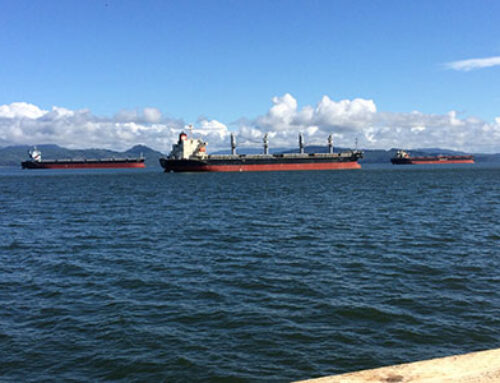Material originally presented in OMEP Webinar, June 23, 2020.
By- Debra Mervyn- The Mervyn Group
- In-Shoring is defined as using USA based manufacturers and suppliers for the outsourced activities.
- Near-Shoring (or Regionalization) is the use of countries located on a continent or region for the outsourced activities.
- Reshoring is bringing back previously offshored activities to North America. In this article, reshoring is used synonymously for Nearshoring and Inshoring.
New interest in wake of COVID-19
April 2020 Forbes magazine spotlighted the new interest in Reshoring. ““China has ‘nationalized’ the big N95 mask manufacturers, making it harder for buyers here to get their hands on a product that, once again, China dominates, says a big U.S. importer. “All of our orders, for millions of N95 masks, were canceled last week,” says Leo Friedman, CEO of iPromo in Chicago, who has been importing tens of millions of masks all month. “They were for hospitals and state governments. We told them last week that we can’t get them.”” The next alarm rang when the U.S. dependence on pharmaceutical products from China was revealed and more interest followed.
Reshoring is not new, but a new awareness. The history of Reshoring goes back more than 10 years. Reshoring is happening, and it is an opportunity for companies in the northwest. Not all companies will Reshore, but many will. What shore they are on depends on Customer location and supply chain and more.
- US Federal Reserve decision to raise interest rates so imports became “cheaper”,
- Unionization of labor which forced companies to move to the Southeast U.S. and then offshore, and
- Trade deals (i.e. NAFTA) and “Free Trade” Agreements that were not so free.
and the idea that products and services could be had at lower cost or, so it was thought.
Most manufacturers and service providers did not evaluate all the variables and costs associated with customer or consumer demands, true cost materials and components and of landed goods and services, and supply chain and logistics. In addition, offshoring sacrificed American jobs, self-sufficiency, and manufacturing base, as well as product diversity, quality, and delivery and more.
What about risk? The risk of offshoring is known to many manufacturers and service providers, but was less apparent to consumers until now. The COVID-19 scare brought these hidden risks and realities to light, in a big and immediate way.
The Economist published a series of articles in 2019 describing the latest trends and factors, costs and risks driving Reshoring including: Link- Article 1 Link- Article 2
- The lack of wisdom of hyper globalization uncovered by true cost accounting
- Planning and the wisdom of shorter, smarter, and faster supply chains to meet customer demands
- Benefits of reduced inventory and cheaper logistics, shorter cycle times by suppliers being closer to consumers
- Risk- Supplier, political, tariffs and trade agreements, and the Chinese New Year
- China’s increasing labor and related costs
- Customer demands for higher quality and more diverse products
- Expansion of customization and the acceleration of innovation
The article foretold of the “new” supply chain strategies and realities which were revealed to the general public in the wake of COVID-19.
Soaring Chinese wages and these factors lead to the decline in the cheap China Souring model. These open secrets were not hidden but were lurking problems, with potentially devastating outcomes. Producers are realizing that things are best done close to consumer.
Case Examples and Drivers
Eight years ago, Whirlpool/ Kitchen Aid, Char-Broil, Otis Elevator, Caterpillar, General Electric and Ford Motor company were Reshoring based on “doing the math”. “For Whirlpool, the decision to assemble hand mixers in the US was based on complicated calculations that varies for every manufacturer contemplating reshoring: the amount of money it saves on shipping and inventory, for example, off sets the higher wages it pays American workers.”
The calculations were not complicated. They were based on Value Stream Cost Accounting. These companies discovered it was not more profitable to make certain products offshore. They were able to make products in the U.S.A. with more profit, less lead time, minimized risk, and greater customer satisfaction. What did they find in the analysis? Unquantified costs rolled up into Overhead and Admin and related to
- Taxes, tariffs
- Currency exchange rates
- Customs and delays, shortages and missed shipments
- Rising Chinese labor costs
- Batch size
- Inventory
- Quality and cost of quality (defective products or components and the rework, repair and scrap and dissatisfied customers)
- Shipping
- Suppliers (lead time and logistics, intellectual property and knockoffs, currency stability, culture and political stability)
- Management of suppliers to ensure process controls and viable quality systems
- Risk
The risk and cost associated with suppliers, supply chains, supply chain interruption, long lead times, and quality were exposed. Each one of these factors presented an opportunity for change and improvement.
These companies took a fresh look at their financial reports and cost accounting. Accurate cost accounting started to expose hidden costs chipping away at margins. Once extracted, these costs became “surprises” not so welcomed by owners, board members, investors, and accountants. The companies discovered they could improve not only financial performance but capture more market share, increase sales revenue, and improve customer response by Reshoring.
Because the foundation is laid, interest in Reshoring is moving forward at a greater speed and intent ahead of and in the wake of COVID-19.
Black and Decker is leaving China and is Reshoring. Stanley Black & Decker is Reshoring More Production of Craftsman Tools and started early 2019. Medical Device companies in Oregon and Southwest Washington are ahead of this curve and gearing up to accelerate Reshoring. A new pharmaceutical manufacture is moving into the Spokane Valley.
All sizes of companies are Reshoring from 15 million up. Some companies have high quality and regulatory drivers, including medical device, pharmaceutical, and printed circuit board assembly and more. Companies who are critical thinking around cost, quality and logistic drivers and risk are also Reshoring.
Customer Demands for Higher Quality and More Diverse Products
Goods and services produced offshore were so “cheap” and, yes, break regularly and as planned. Millennials figured “cheap” out and antique or vintage shopping became in vogue to find sustainable, diverse and high-quality products.
The companies Reshoring can produce higher quality products and also respond to consumer demands more quickly. Lead times are shorter, quality is better, products last longer, and they can make diverse products instead of cookie cutter volumes.
By producing closer to the consumer companies are able to expand customization, accelerate innovation and speed up delivery. Lead times are short, more flexible and dependable, and quality better which creates time and capacity for innovation and creativity.
Jeff Fettig, Whirlpool’s Chief Executive Officer, said the company had more flexibility now that it makes the hand mixers in the U.S. “” If retailers suddenly want a different color or design, Whirlpool can ship it to them in a week or two, compared with a month or more needed to make and ship a changed production from a Chinese plant. “Any change in the marketplace and we can change like that,” said Mr Fettig, snapping his fingers.””
Identifying and Finding New Suppliers and Supply Chains
Supply chains can serve as a basis for competitive advantage. Companies now Plan, Source, Make and Deliver as one cohesive organization, if they are smart. With Reshoring, supplier chains become shorter but also faster and smarter and more dependable.
Reshoring initiates a fresh look for suppliers and supply chains which creates opportunities for businesses in a region. How do OEMs and Contract Manufacturers find and qualify these suppliers and visa versa? What is the new marketing, social media and sales approach?
How do suppliers prepare for the need? The answer is the same value stream cost assessment and process engineering approach used by OEMs and Contract Manufacturers.
Role of Optimizing Operation and Production Efficiency
In addition to supply chain improvements, Reshoring companies had to improved operational efficiency in order to accomplish their goals. Improvements were made across the entire Value Stream- Customers, Suppliers, Planning, Production and Logistics. Key to being able to able to compete with Offshore sources included need to improve operations and production efficiency to lower costs and meet quality and delivery targets.
“Core Systems has cut costs partly by training operators to handle several machines at a time and reorganizing its factory so parts don’t have to move around so much while product are being put together. Robots trim excess plastic off parts, a job formerly done by hand.”
Changes include technology solutions, Operational Excellence, Lean manufacturing, Sales Inventory and Operational Planning (SIOP), Automation and AI, and the use of 3D Printing. A combination of improvements enabled these companies to reduce costs of goods, stay competitive and exceed China factory performance.
Robotics is the chatter and may be useful when warranted, but it is not a panacea or needed in most cases. Automation accompanying Reshoring focused on information technology (AKA AI) solutions for inventory control and management, stock and demand forecasting, vendor order placement/ invoice and payment, logistics planning/ documentation paperless and execution (ie Amazon), and 3D printing for tooling and parts.
What about Sustainability? A New Twist and Reason to Reshore.
As described, we thought goods and services were so “cheap” and, yes, break regularly and as planned. Consumers are seeking sustainable, diverse and high-quality products. Consumers want sustainable products that don’t break every 2-5 years and head to a landfill.
Reshoring also has a social aspect and one that is becoming more apparent to the public. China and other country’s track record for Worker’s rights and wages, human trafficking and slave labor, compliance with environmental law/ regs, animal research and rights issues are troubling. By Reshoring consumers and producers are improving environmental and social responsibility and national security.
Planning Reshoring
Your head is spinning at the daunting task of evaluating Reshoring. Framing and planning the project is key to success. Is Reshoring a requirement or a feasibility study? Is the project time sensitive related to an opportunity, or is there a risk of losing customers?
Define the specific product targets? Define variables associated those specific targets, including consumers and market, cost sensitivity, volumes, etc. Define and understand risks associated with Reshoring.
Develop a project plan and a cross-functional team composed of stakeholders including subject matter experts (SME’s) from engineering, manufacturing, supply-chain/planning, finance, sales, and executive sponsor.
Now that you understand the assignment, where and how do you start? Conduct a comprehensive value stream cost assessment and determine total cost of ownership and margins and changes and improvements needed to accomplish your goals. Evaluate maintaining security of supply (no missed customer commitments), the supplier or partner selection process, and schedule. Determine the changes needed to improve operational efficiency and reduce operating and manufacturing costs on shore.
Assess your internal resources. Understand your internal capabilities and external resource needs. Does your company have expertise in complex international material and product transfers? Do you have a robust supplier identification and vetting and qualification process? Do you have tools helps rank the suppliers or any other complex decision?
Plan for transfer of production and negotiation with existing suppliers. How will current suppliers react to the decision to move the business? What contingencies need to be created? Outside resources have proven tools and expertise that will help facilitate and greatly improve the odds for a successful transfer.
The Mervyn Group is ready to help you
- Evaluate cost of goods/ services sold in a comprehensive way (Value Stream Cost Accounting) along with opportunities for improvement,
- Optimize processes and maximize efficiency (Operations Excellence, LEAN, SIOP, Technology and Automation), and
- Identify new suppliers and supply chains.
- Enable your organization to rebound, survive and grow, and perhaps jump on the momentum to our shore.
Contact Debra Mervyn Debra@MervynGroup.com to learn more.





